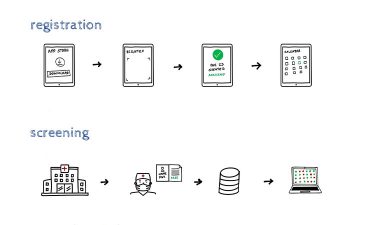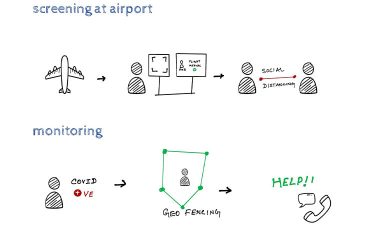COVID-19: Can airports nip pandemics in the bud?
- Like
- Digg
- Del
- Tumblr
- VKontakte
- Buffer
- Love This
- Odnoklassniki
- Meneame
- Blogger
- Amazon
- Yahoo Mail
- Gmail
- AOL
- Newsvine
- HackerNews
- Evernote
- MySpace
- Mail.ru
- Viadeo
- Line
- Comments
- Yummly
- SMS
- Viber
- Telegram
- Subscribe
- Skype
- Facebook Messenger
- Kakao
- LiveJournal
- Yammer
- Edgar
- Fintel
- Mix
- Instapaper
- Copy Link
Posted: 15 April 2020 | Anu Pillai S | No comments yet
We are witnessing perhaps the biggest crisis of the 21st century. Declared a pandemic by the World Health Organization, COVID-19 has affected every aspect of life worldwide. Airports, which ferry millions of passengers every day, unwittingly became the gateway for this contagion.
There is no clear mechanism in place to monitor passenger movement, screen and test them for infection, and assist authorities to monitor and geo-fence quarantined cases. With the help of such plans, perhaps COVID-19 could have been nipped in the bud. But it’s not too late. airports can still play a key role in containing the current pandemic spread.


Mobility: A identity management app in line with OneID
In the coming days, airports must re-engineer air travel procedures to help quell the spread of the coronavirus. Passenger screening and testing should become a part of passenger processing, as mandatory as a travel document, and conducted well before departure or arrival. This health-record data, captured from a network of health centres, can be tracked and actioned. A mobile-enabled identity management application comprised of identification, medical records and powered by assurance levels (ISO/IEC 29115 Authentication Assurance Framework) can achieve this.
OneID is an initiative by ACI and IATA to enable a friction-free, passenger-centric process allowing an individual to assert their identity online or in person to the required level at every process step, while maintaining the privacy of personal data. OneID, altered or appended with medical records and tracking systems in case of to-be-self-quarantined passengers, can help countries contain the pandemic.
Airports can quickly deploy and transform the existing eGates to screen, track and monitor passenger movement based on the updated health records. For instance, every passenger will be required to generate a unique ID and undergo a medical examination (in this instance a COVID-19 screening) at the airport or at one of the network hospitals prior to travel; a process similar to Visa stamping that is mandatory in most countries. People who test negative will be cleared for travel, while others will require further medical examination. The detained passenger intercepted at arrival or departure (second round of testing) will be put up in a quarantine/medical zone for further action, containing the transmission at source. OneID can also enable the collaboration this exercise required between countries and their medical staff.
Manage and monitor quarantined cases
There have already been cases of people trying to avoid quarantine even as authorities try to detain them, and that’s likely to continue. With OneID, airports can enable eGates to deny entry or exit based on facial recognition validations or RFID flags. When passengers arriving at the airport are screened and detected with fever, an RFID/ facial recognition aided flag will not allow the passenger to pass through the exit gate. This will help authorities ensure that detained cases remain in quarantine, preventing cases from slipping through the cracks. These contactless checks can be put in place immediately and at minimal cost.
Furthermore, the identity management application can enable location services to geo fence passengers post-travel, whether they are self-quarantined or under supervision. Additionally, it could become a gateway to interact with the affected people to provide essential services and medical assistance.


Additional steps to make airports safe zones
The biggest challenge for airports is to ensure passengers remain comfortable amid fears of spreading COVID-19. By having access to information, observing social distancing, staff screening and safety maintenance can allay these fears and make travellers more comfortable.
Airports as information zones
In addition to ensuring infected people don’t travel, airports can become information hubs, helping spread awareness about COVID-19. This can be done via advertising displays, interactive touch-free kiosks or the Identity Management mobile app.
Physical distancing and contactless transactions
To ensure physical distancing, there is a need to define a threshold of passengers airports can accommodate in a single day. OneID data can help determine when capacity is reached. In addition, integrating more spread out retail spaces, gesture/mobile-based touch-free transactions and indoor navigation systems to direct passenger movement can also contribute to maintaining the required distance.
Staff health and hygiene measures
Airport facilities and staff also must follow firm health and safety protocols at all levels – even the baggage needs to be sanitised. Airports should operate like niche pharmaceutical companies where the margin for error in air and surface quality is virtually zero. Both the facility and employees must follow and practice firm protocols, like doctors and staff at hospitals currently serving those infected by COVID-19.
All these measures require another look at the current processes and ways to help airports, stakeholders and passengers implement these changes. Cooperation in following revised norms and adhering to the new process will go a long way in containing the ongoing pandemic. After all, we are in this together.
Want to know more about how deploying OneID can help contain COVID-19 at airports? Let’s talk [email protected]
Biography


Anu Pillai S – Digital Transformation Leader, leads the Digital Center of Excellence at Wipro’s EC&O vertical, that caters to engineering and construction, transportation infrastructure (airports, metros, ports) and smart cities. He has over 12 years of consulting experience to do with the evangelisation and development of new-age digital solutions. He has worked with leading EC&O organisations across the globe on businesses transformation engagements.
Advisor


Related topics
Airport crisis management, Contactless / Touchless technology, COVID-19, Information technology (IT)

















